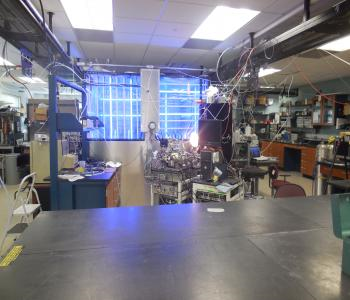1F: ACOM Environmental Chamber
Experiments have begun in the newly commissioned ACOM environmental chamber. This is a 10 m3 PFA (Teflon) bag suspended inside a reflective housing. Surrounding the chamber are 128 fluorescent lights, which can be turned on incrementally to achieve different levels of UV radiation inside the chamber. A number of instruments are connected to the chamber to measure and record common variables such as temperature, humidity, particle size distributions and ozone. Numerous sampling ports allow more specialized equipment to be connected for targeted studies. Experiments have recently been performed to characterize the chamber, and also to assess the response of various instruments to different chemicals produced in the chamber.
As an example of the synergy between different experimental groups in ACOM, experiments have been conducted to investigate the response of our instrumentation to hydroperoxides and hydroxynitrates. It has been demonstrated that isoprene hydroxyhydroperoxides can decompose in some instruments (PTRMS, GC-FID) to produce carbonyls (methacrolein and methyl vinyl ketone), thus skewing the product distributions obtained under low-NOx conditions. We have oxidized isoprene, butene and butane in the Teflon chamber under high-NOx and low-NOx conditions, and sampled the organic reaction products using PTRMS (Zhang, Ortega) and the TOGA GC-MS (Apel, Hills, Hornbrook and Asher). The experiments confirmed that hydroperoxides do decompose when sampled by PTRMS, but that TOGA did not suffer from this interference. The use of butene and butane enabled us to compare the behavior of a simple hydroperoxide (from butane) with the multifunctional peroxides derived from butene and isoprene. Such experiments help to elucidate the complex oxidation chemistry, while providing essential information on the response of field instruments under controlled laboratory conditions.
The chamber can be operated in both batch (static) or in steady-state continuous flow mode. The latter is especially useful for the study of atmospheric chemistry under ‘intermediate NO’ conditions that bridge the gap between ‘high-NO’ and ‘low-NO’ conditions, which have been extensively investigated in traditional batch-mode chambers. In particular, the ‘intermediate NO’ chemical regime is characterized by constant sub-ppb levels of NO and can be created in the chamber by precise control of the inflow NO concentration and the chamber residence time. Over the range of conditions achievable in the chamber, the lifetime of peroxy radicals (RO2), key intermediates from the atmospheric degradation of volatile organic compounds (VOCs), can be extended to several minutes. Given these chamber lifetimes a diverse array of reaction pathways, including unimolecular pathways, and bimolecular reactions with NO and HO2, can thus be explored. Characterization experiments under photolytic and dark conditions have been performed and, in conjunction with model predictions, provide a basis for interpretation of prevailing atmospheric processes in environments with intertwined biogenic and anthropogenic activities.

Contact
Please direct questions/comments about this page to:
Carl Drews
NSF NCAR | Research IT | ACOM